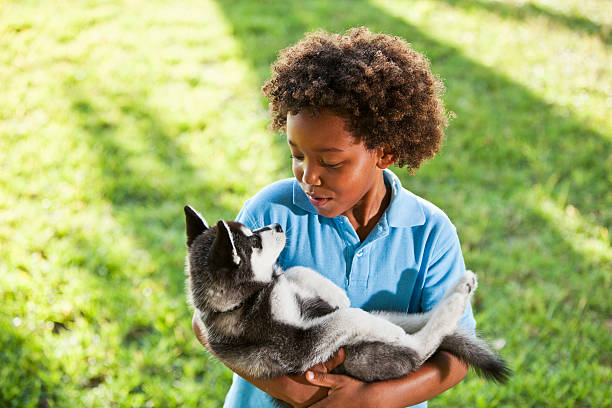As a father, seeing your kid and their dog together is something special. It’s more than just playtime; it’s a lesson in life. Dogs teach kids about caring, sharing, and being a good friend, all without saying a word. Every wag, every lick, it’s like they’re saying, “This is how you do it.” It’s a team effort that shows your child the ropes of growing up, making every moment with their furry friend a valuable lesson in love and life.
Responsibility and Routine
Imagine being a kid again, where every day brings a new adventure and even the smallest tasks hold a world of discovery. In the midst of this, caring for a family dog becomes a cherished part of the daily rhythm. For kids, feeding their canine friend isn’t just ticking a box; it’s an early lesson in responsibility. Deciding what’s the best nutrition, like choosing the right food for your American Bully, becomes an act of care wrapped in love.
And then, there’s the routine. Morning walks that happen come rain or shine, grooming sessions that are less about the chore and more about the bond it strengthens, and playtime that’s as essential for the dog as it is fun for the child. Through these daily rituals, children learn the value of consistency, the importance of looking after someone else, and the undeniable joy that comes from a happy bark or a wagging tail.
These moments aren’t just routines; they’re the life lessons in discipline and reliability that kids carry into their future, illustrating how everyday responsibilities can shape their character and approach to life.
Compassion and Empathy
Amid every playful chase and gentle nuzzle lies a deeper connection between a child and their dog. This bond is more than just companionship; it’s a classroom without walls where lessons in compassion and empathy are taught without words. Dogs, with their intuitive understanding and expressive eyes, become guides in the art of feeling and understanding the emotions of others.
Children learn to read the subtle signals their canine friends send— a drooped tail, an eager wag, or a soft whine. These non-verbal cues teach them to tune into the feelings and needs of those around them, sharpening their ability to empathize with others. It’s a gentle introduction to understanding emotions, both in themselves and in their furry companions.
Caring for a dog also exposes children to the reality that every living being has needs and feelings. This realization fosters a sense of empathy; kids begin to see the world from perspectives other than their own. They learn that kindness and care can cross the boundaries of species, planting the seeds of compassion that will grow with them through life.
Physical Activity and Health
In a world increasingly dominated by screens, the companionship of a dog emerges as a vibrant beacon, guiding young ones toward the wonders of the great outdoors. What might seem like a simple task—walking a dog—transforms into an epic adventure for youthful explorers. These daily excursions offer more than just a breath of fresh air; they lay the foundation for a physically active lifestyle.
This natural synergy between play and exercise is pivotal. As children engage in active pursuits like chasing after a ball or jogging alongside their dog, they’re not just burning off energy. They’re developing crucial motor skills, establishing healthy exercise habits, and learning the value of staying active. Such activities are essential in combating sedentary lifestyles and reducing the risk of childhood obesity.
The benefits extend beyond the immediate physical advantages. Regular outings with a dog can lead to improved cardiovascular health and more consistent sleep patterns for children. Plus, as kids take on the responsibility of ensuring their dogs are well-fed and healthy, they encounter valuable lessons in nutrition. For instance, as they choose a dog food that contains beneficial vitamins and minerals, they also learn about the importance of a balanced and healthy diet in their own lives. It’s through these shared experiences of care, activity, and nutritional awareness that children grasp the broader concept of health.
Additionally, you also need to ensure that you’re providing a safe outdoor environment for both children and pets. A wireless dog fence provides a secure boundary, allowing dogs to roam freely while also giving families peace of mind. This added safety measure encourages more outdoor play and reinforces the importance of having an active lifestyle for both the kids and their companions. It’s through these shared experiences of care, activity, and nutritional awareness that kids grasp the broader concept of health.
Social Skills and Friendship
Navigating the world of social skills and forming friendships is a journey filled with varied lessons, where both family and pets play significant roles. In this dynamic, the companionship of a dog emerges not just as a source of joy, but as a unique teacher of empathy and connection. Just as fathers can impact the lives of their kids by modeling positive social behaviors and offering guidance, dogs contribute to this learning in their own way. They teach children about trust, compassion, and the art of friendship through their unconditional love and interactions.
For many children, a dog is their first friend, an ever-present companion who listens without judgment and offers comfort without conditions. This relationship lays the groundwork for understanding the dynamics of friendship, empathy, and support.
Moreover, dogs often serve as social bridges, connecting children with their peers. A trip to the park or a walk around the block becomes an opportunity to meet others, share experiences, and make new friends bonded over their common love for dogs. These interactions enhance a child’s social circle and teach the importance of community and belonging.
Wrapping Up
Dogs are not just pets hanging around the house; they’re like wise old friends wrapped in fur, teaching kids about life without ever saying a word. From showing them the ropes of responsibility to unlocking the secrets of heartfelt friendships, these four-legged tutors leave a mark that sticks with kids as they grow.
So, here’s to our furry friends and the countless lessons they teach, making life a bit richer, one bark at a time.





